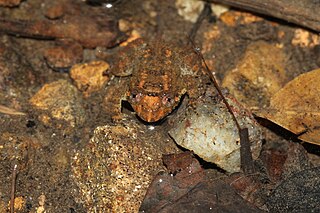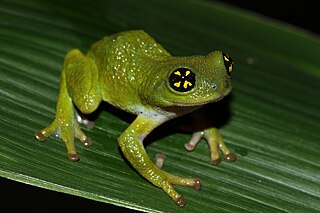
The Bombay night frog, also known as Abdulali's wrinkled frog, Abdulali's night frog or Humayun's wrinkled frog, is a species of frog in the family Nyctibatrachidae. It is endemic to the Western Ghats of Maharashtra state, India. The species is found near torrential hill streams in tropical moist evergreen and semi-evergreen forests, a habitat that is threatened by habitat loss and pollution. Its name honours Humayun Abdulali, an Indian biologist.

Nyctibatrachus major, the Malabar night frog, large wrinkled frog, or Boulenger's narrow-eyed frog, is a species of frog in the family Nyctibatrachidae, commonly known as the robust frogs. It was described in 1882 by the zoologist George Albert Boulenger, and is the type species of the genus Nyctibatrachus. It is a large frog for its genus, with an adult snout–vent length of 31.5–52.0 mm (1.24–2.05 in) for males and 43.7–54.2 mm (1.72–2.13 in) for females. It is mainly brownish to greyish in colour, with a dark greyish-brown upperside, a greyish-white underside, and light grey sides. It also has a variety of grey or brown markings. When preserved in ethanol, it is mostly greyish-brown to grey, with whitish sides. Sexes can be told apart by the presence of the femoral glands in males.

Raorchestes beddomii is a species of frog in the family Rhacophoridae. It is endemic to southern Western Ghats of southwestern India in Kerala and Tamil Nadu (Kannikatti). Its name honours Colonel Richard Henry Beddome who collected the type specimen.

Raorchestes chalazodes is a species of critically endangered frog in the family Rhacophoridae. Raorchestes chalazodes is a nocturnal and arboreal species found in the understorey of tropical moist evergreen forest and is endemic to the Western Ghats of India. The specific name chalazodes is composed of the Greek word χάλαζα (chalaza) meaning "lump" and -odes for the derived adjective, reflecting white granulation of the body.

Raorchestes glandulosus, also known as glandular bush frog, rough-skinned bush frog, southern bubble-nest frog, and with many other names, is a species of frog in the family Rhacophoridae. It is endemic to the Western Ghats, India, and known from the states of Karnataka and Kerala.

Raorchestes griet is a species of frog in the family Rhacophoridae. It is endemic to the Western Ghats south of the Palghat Gap in Kerala and Tamil Nadu states, India. The specific name griet honours Griet Decock, spouse of Franky Bossuyt, the scientist who described the species. Common name Griet bush frog has been coined for it.

Raorchestes luteolus is a species of frog in the family Rhacophoridae. It is endemic to the Western Ghats, India, where it is only known from the state of Karnataka. Many of the known populations are from the Kodagu district, known also by its anglicised former name of Coorg—hence the common name. It is also known from the Shimoga district in the Sharavathi basin where it was described as a new species, Philautus neelanethrus, but this is now considered to be a junior synonym of Raorchestes luteolus.

Raorchestes nerostagona is a species of frog in the family Rhacophoridae. It is endemic to the Western Ghats, India. It has been called as the Kalpetta yellow bush frog or lichen bush frog for its patchy lichen like patterning that make it cryptic. First described in 2005 based on a specimen obtained in Kalpetta, the species has subsequently been found in many parts of the Western Ghats.

Raorchestes tinniens, also known as the spotted bush frog, black bush frog, and Rao's bubble-nest frog, is a species of frog in the family Rhacophoridae. It is endemic to the Nilgiri Hills, a part of the Western Ghats, in Tamil Nadu and Kerala, southern India. It has a rather complicated taxonomic history, and there is still an open issue whether Ixalus montanusGünther, 1876 from Kudremukh (Karnataka), now in synonymy with Raorchestes tinniens, is indeed a valid species.

Raorchestes travancoricus, variously known as the Travancore bushfrog, Travancore bubble-nest frog, or Travancore tree frog, is a species of frog in the family Rhacophoridae. The species is endemic to the southern Western Ghats, India. Its specific name, travancoricus, as well as its three common names, refer to its type locality, Bodinayakkanur in the former Travancore state.

Pseudophilautus wynaadensis, commonly known as the Wayanad bush frog, common bush frog, jerdon's bush frog,plain-colored bush frog, Malabar coast frog, or dark-eared bush frog, is a species of frog in the family Rhacophoridae. It is endemic to the Western Ghats of southwest India.

Ghatixalus variabilis is a species of frog in the family Rhacophoridae. It is endemic to the Western Ghats of southern India. It has a number of common names, including green tree frog, though it is terrestrial rather than arboreal in its life style.

Raorchestes anili is a species of frog in the family Rhacophoridae.

Raorchestes resplendens, the resplendent shrubfrog, is a critically endangered species of frog belonging to the family Rhacophoridae endemic to the high altitude region around the south Indian peak of Anaimudi. It has extremely short limbs and numerous macroglands and was discovered from the Anamudi summit in the Western Ghats of Kerala, India and is known only from the Eravikulam National Park.

Pseudophilautus is a genus of shrub frogs in the family Rhacophoridae endemic to the Western Ghats of southwestern India and to Sri Lanka where the majority of the species are found. Many of them are already extinct. On the other, some species believed to be extinct have also been rediscovered.

Raorchestes is a genus of frogs in the subfamily Rhacophorinae that are found in mountainous regions of South Asia, Southeast Asia, and southern China. A recent study places Raorchestes as a sister taxon of Pseudophilautus. Before the description of the genus in 2010, species now in Raorchestes had been assigned to genera Ixalus, Philautus, and Pseudophilautus.

Raorchestes akroparallagi is a species of frogs in the family Rhacophoridae.

Xanthophryne tigerina, sometimes known as the Amboli toad, is a species of toads. It is endemic to the Western Ghats of India and known only from the vicinity of Amboli in Maharashtra. It was described as a new species in 2009 and placed in a new genus along with its sister species Xanthophryne koynayensis.

Raorchestes coonoorensis, also known as the Coonore bushfrog or Coonoor bush frog, is a species of frogs endemic to the Western Ghats, India. It is reported from its type locality, Sim's Park in Coonoor, with an additional observation from Kothagiri; both locations are in the state of Tamil Nadu. Its altitudinal range is 1,780–1,850 m (5,840–6,070 ft) asl.

The kani bushfrog or kani brown-eared shrub frog is a small shrub frog species of the genus Pseudophilautus. It is endemic to India, where it has been observed in the Western Ghat mountains and Tamil mountains.
























